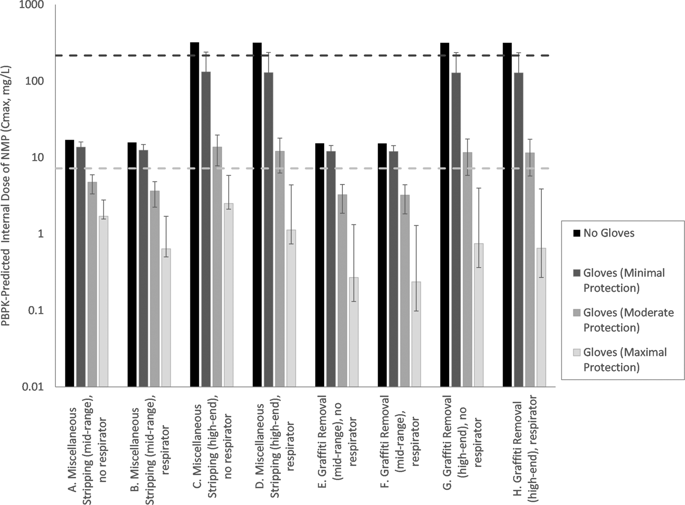当前位置:
X-MOL 学术
›
J. Expo. Sci. Environ. Epid.
›
论文详情
Our official English website, www.x-mol.net, welcomes your
feedback! (Note: you will need to create a separate account there.)
Using physiologically-based pharmacokinetic modeling to assess the efficacy of glove materials in reducing internal doses and potential hazards of N-methylpyrrolidone during paint stripping.
Journal of Exposure Science and Environmental Epidemiology ( IF 4.1 ) Pub Date : 2020-03-09 , DOI: 10.1038/s41370-020-0218-2 C R Kirman 1
Journal of Exposure Science and Environmental Epidemiology ( IF 4.1 ) Pub Date : 2020-03-09 , DOI: 10.1038/s41370-020-0218-2 C R Kirman 1
Affiliation

|
A refined risk assessment was conducted to evaluate the efficacy of different glove materials in reducing the potential hazards associated with using paint strippers containing N-methylpyrrolidone (NMP) under the scenarios defined by USEPA's TSCA risk assessment. Three categories of gloves were identified based on measured permeation rates for NMP: (1) minimal protection; (2) moderate protection; and (3) maximal protection. Simulations for eight acute and chronic occupational exposure scenarios identified by USEPA as having a potential hazard (i.e., margins of exposure, MOE, <30) were reassessed for each glove category using PBPK modeling to predict peak (Cmax) and cumulative (AUC) internal doses of NMP. For the acute assessment, the refined MOE values were ≥30 for half of the scenarios for gloves from the moderate protection group category, and all of the scenarios for gloves from the maximal protection category. For the chronic assessment, the refined MOE values were ≥30 for all scenarios except one for gloves from the maximal protection category. The results of this assessment indicate that: (1) the degree of protection provided by gloves from NMP permeation can vary widely depending upon the glove material, NMP formulation, and internal dose measure (with calculated glove protection factors ranging from 1.1 to 1900); and (2) NMP-containing paint strippers can be used safely when appropriate PPE are used. As such, these results can be used to support risk-reduction methods (e.g., product labeling, MSDS instructions on use of appropriate glove materials) as alternatives to banning NMP use under TSCA.
中文翻译:

使用基于生理的药代动力学模型来评估手套材料在脱漆过程中减少内部剂量和N-甲基吡咯烷酮的潜在危害的功效。
在USEPA的TSCA风险评估定义的情况下,进行了精细的风险评估,以评估不同手套材料在减少与使用含N-甲基吡咯烷酮(NMP)的脱漆剂相关的潜在危害方面的功效。根据NMP的渗透率确定了三类手套:(1)最低防护;(2)适度保护;(3)最大限度的保护。使用PBPK模型对每个手套类别重新评估了USEPA确定的具有潜在危害(即接触余量,MOE,<30)的八种急性和慢性职业暴露情景的模拟,以预测内部的峰值(Cmax)和累积(AUC)剂量的NMP。对于急性评估,在中等保护组类别的手套中,一半情况下的精确MOE值≥30,以及所有防护级别最高的手套场景。对于慢性评估,除最大防护类别的手套之一外,所有情况下的精确MOE值均≥30。评估结果表明:(1)手套对NMP渗透的保护程度可能会因手套材料,NMP配方和内部剂量测量值而有很大差异(计算得出的手套保护系数范围为1.1至1900);(2)当使用适当的PPE时,可以安全地使用含NMP的脱漆剂。因此,这些结果可用于支持降低风险的方法(例如,产品标签,使用适当的手套材料的MSDS指导),作为禁止在TSCA中使用NMP的替代方法。对于慢性评估,除最大防护类别的手套之一外,所有情况下的精确MOE值均≥30。评估结果表明:(1)手套对NMP渗透的保护程度可能会因手套材料,NMP配方和内部剂量测量值而有很大差异(计算得出的手套保护系数范围为1.1至1900);(2)当使用适当的PPE时,可以安全地使用含NMP的脱漆剂。因此,这些结果可用于支持降低风险的方法(例如,产品标签,使用适当的手套材料的MSDS指导),作为禁止在TSCA中使用NMP的替代方法。对于慢性评估,除最大防护类别的手套之一外,所有情况下的精确MOE值均≥30。评估结果表明:(1)手套对NMP渗透的保护程度可能会因手套材料,NMP配方和内部剂量测量值而有很大差异(计算得出的手套保护系数范围为1.1至1900);(2)当使用适当的PPE时,可以安全地使用含NMP的脱漆剂。因此,这些结果可用于支持降低风险的方法(例如,产品标签,使用适当的手套材料的MSDS指导),作为禁止在TSCA中使用NMP的替代方法。评估结果表明:(1)手套对NMP渗透的保护程度可能会因手套材料,NMP配方和内部剂量测量值而有很大差异(计算得出的手套保护系数范围为1.1至1900);(2)当使用适当的PPE时,可以安全地使用含NMP的脱漆剂。因此,这些结果可用于支持降低风险的方法(例如,产品标签,使用适当的手套材料的MSDS指导),作为禁止在TSCA中使用NMP的替代方法。评估结果表明:(1)手套对NMP渗透的保护程度可能会因手套材料,NMP配方和内部剂量测量值而有很大差异(计算得出的手套保护系数范围为1.1至1900);(2)当使用适当的PPE时,可以安全地使用含NMP的脱漆剂。因此,这些结果可用于支持降低风险的方法(例如,产品标签,使用适当的手套材料的MSDS指导),作为禁止在TSCA中使用NMP的替代方法。(2)当使用适当的PPE时,可以安全地使用含NMP的脱漆剂。因此,这些结果可用于支持降低风险的方法(例如,产品标签,使用适当的手套材料的MSDS说明),作为禁止在TSCA中使用NMP的替代方法。(2)当使用适当的PPE时,可以安全地使用含NMP的脱漆剂。因此,这些结果可用于支持降低风险的方法(例如,产品标签,使用适当的手套材料的MSDS指导),作为禁止在TSCA中使用NMP的替代方法。
更新日期:2020-04-24
中文翻译:

使用基于生理的药代动力学模型来评估手套材料在脱漆过程中减少内部剂量和N-甲基吡咯烷酮的潜在危害的功效。
在USEPA的TSCA风险评估定义的情况下,进行了精细的风险评估,以评估不同手套材料在减少与使用含N-甲基吡咯烷酮(NMP)的脱漆剂相关的潜在危害方面的功效。根据NMP的渗透率确定了三类手套:(1)最低防护;(2)适度保护;(3)最大限度的保护。使用PBPK模型对每个手套类别重新评估了USEPA确定的具有潜在危害(即接触余量,MOE,<30)的八种急性和慢性职业暴露情景的模拟,以预测内部的峰值(Cmax)和累积(AUC)剂量的NMP。对于急性评估,在中等保护组类别的手套中,一半情况下的精确MOE值≥30,以及所有防护级别最高的手套场景。对于慢性评估,除最大防护类别的手套之一外,所有情况下的精确MOE值均≥30。评估结果表明:(1)手套对NMP渗透的保护程度可能会因手套材料,NMP配方和内部剂量测量值而有很大差异(计算得出的手套保护系数范围为1.1至1900);(2)当使用适当的PPE时,可以安全地使用含NMP的脱漆剂。因此,这些结果可用于支持降低风险的方法(例如,产品标签,使用适当的手套材料的MSDS指导),作为禁止在TSCA中使用NMP的替代方法。对于慢性评估,除最大防护类别的手套之一外,所有情况下的精确MOE值均≥30。评估结果表明:(1)手套对NMP渗透的保护程度可能会因手套材料,NMP配方和内部剂量测量值而有很大差异(计算得出的手套保护系数范围为1.1至1900);(2)当使用适当的PPE时,可以安全地使用含NMP的脱漆剂。因此,这些结果可用于支持降低风险的方法(例如,产品标签,使用适当的手套材料的MSDS指导),作为禁止在TSCA中使用NMP的替代方法。对于慢性评估,除最大防护类别的手套之一外,所有情况下的精确MOE值均≥30。评估结果表明:(1)手套对NMP渗透的保护程度可能会因手套材料,NMP配方和内部剂量测量值而有很大差异(计算得出的手套保护系数范围为1.1至1900);(2)当使用适当的PPE时,可以安全地使用含NMP的脱漆剂。因此,这些结果可用于支持降低风险的方法(例如,产品标签,使用适当的手套材料的MSDS指导),作为禁止在TSCA中使用NMP的替代方法。评估结果表明:(1)手套对NMP渗透的保护程度可能会因手套材料,NMP配方和内部剂量测量值而有很大差异(计算得出的手套保护系数范围为1.1至1900);(2)当使用适当的PPE时,可以安全地使用含NMP的脱漆剂。因此,这些结果可用于支持降低风险的方法(例如,产品标签,使用适当的手套材料的MSDS指导),作为禁止在TSCA中使用NMP的替代方法。评估结果表明:(1)手套对NMP渗透的保护程度可能会因手套材料,NMP配方和内部剂量测量值而有很大差异(计算得出的手套保护系数范围为1.1至1900);(2)当使用适当的PPE时,可以安全地使用含NMP的脱漆剂。因此,这些结果可用于支持降低风险的方法(例如,产品标签,使用适当的手套材料的MSDS指导),作为禁止在TSCA中使用NMP的替代方法。(2)当使用适当的PPE时,可以安全地使用含NMP的脱漆剂。因此,这些结果可用于支持降低风险的方法(例如,产品标签,使用适当的手套材料的MSDS说明),作为禁止在TSCA中使用NMP的替代方法。(2)当使用适当的PPE时,可以安全地使用含NMP的脱漆剂。因此,这些结果可用于支持降低风险的方法(例如,产品标签,使用适当的手套材料的MSDS指导),作为禁止在TSCA中使用NMP的替代方法。









































 京公网安备 11010802027423号
京公网安备 11010802027423号